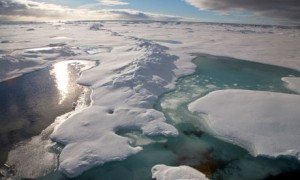Melting Arctic Ice and Methane Gas Bubbles: Is this the final countdown to global warming?
By: Shelly John and Meredith Murray

This week on National Climate Seminar (NCS) at Bard Center for Environmental Policy, we spoke with David Archer, a professor at the University of Chicago in the Department of the Geophysical Sciences. David’s work focuses on the global carbon cycle such as the methane hydrate formation, which is found in ice sheets. The talk focused on comparing methane and carbon dioxide and their effects on Arctic ice as greenhouse gases.
Methane is produced through the decomposition of organic material in low oxygen environments. Today, tropical wetlands are the primary non-anthropogenic source of methane. However, some scientists have expressed concern about Arctic methane, and a potential spike in emissions due to the amplified warming expected in these high northern latitudes. This ‘methane bomb’, as increasing media attention has named it, could occur in arctic due to this release. Temperatures have risen significantly in recent decades and climate scientists predict that this regional amplified warming will continue over the next 100 years. The rapid increase in temperature is contributed to the melting of ice and permafrost, releasing stored methane (methane hydrate and organic carbon) in this ice.

Compared to CO2, methane is much less concentrated in the atmosphere. When comparing the two gases per unit mass, however, methane has a much greater global warming potential. Dr. Archer explained the concept, the band saturation effect, by which methane is a potent greenhouse gas because it is the only gas that absorbs radiation for its specific wavelength. This high impact potential is counterbalanced by low ambient concentrations of methane in the atmosphere and that methane has a relatively short lifespan in the atmosphere. Once methane is released for example, it has a decade until it reacts (oxidizes) with sunlight and hydroxyl radicals, turning into CO2. If there is a constant release of methane from natural and anthropogenic sources it will eventually plateau. On the other hand, CO2 is more abundant in the atmosphere with a longer lifespan of thousands of years, where it is constantly accumulating in oceans and the atmosphere.
Dr. Archer noted that this sudden spike in Artic methane emissions is highly unlikely. In order for this large spike to make a difference in the global warming potential, it would have to all be released within the lifespan of methane – ten years. The ice in this region is so expansive, that it would take a long time to melt, lagging behind the warming temperatures. A slower release of methane would mean it would have time to naturally oxidize to carbon dioxide. The trapped methane is confined by thermodynamics several meters below the sea-floor, making the potential of this “bomb” occurring very low.
Dr. Archer’s message is that anthropogenic and Arctic methane emissions are not the main issue when identifying the potential future threats of global warming. He argues that the primary concern of global warming comes from CO2 and he encourages policy makers to continue focusing on mitigating these emissions. Nevertheless, an ideal solution t o reduce global warming would be to decrease CO2 emissions along with methane emissions.
If you want more information on global warming and humans’ impact on Earth’s systems, check out David’s free online course “Global Warming: The Science of Climate Change”.
To learn more about the National Climate Seminar series and to listen to this conversation with David Archer, please visit http://www.bard.edu/cep/programs/climateseminar/archive/index.php?year=2014


